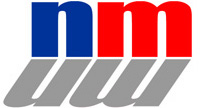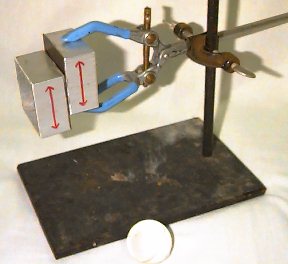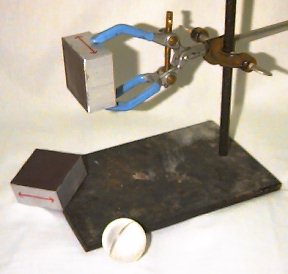

contributing author: Elizabeth Mengelt
Different materials respond to applied stresses in different ways. How a material will respond depends on the arrangement of atoms in the material and how these atoms are bonded together. We have found that flexible sheet refrigerator magnets can be used to show macroscopically how salts and metals respond to an applied stress.
In a metal, the atoms are held together by metallic bonding that pervade the whole structure. This type of bond allows the atoms to slip past each other and still remain bonded together. As a result, metals are able to bend under an applied stress.
Figure 1. Animation of metal deformation at the atomic level. Animation is from the Solid State Resources CD.
In a salt, electrical charges between ions hold the structure together. Neighboring cations (positively-charged ions) and anions (negatively-charged ions) attract each other, but cations repel other cations and anions repel other anions. When a salt crystal is cleaved, the applied stress shifts the positions of cations and anions. If the crystal lattice is deformed, repulsions between similar charges in the crystal may result repulsive forces can shatter the crystal.
Figure 2. Animation of salt cleavage at the atomic level. Animation is from the Solid State Resources CD.
The unusual magnetic structure of flexible sheet refrigerator magnets allows demonstrations of both of these processes. The magnets are mounted on blocks with their back (unprinted) sides facing outward. One block is clamped to a ring stand as shown in Figure 3. The other block is magnetically attracted to the first by interaction of the refrigerator magnets. A stress is applied to the unclamped block by dropping a small ball on the top surface of the unclamped block. If the magnets' pole stripes are oriented perpendicular to the ground (and if the ball strikes the top face softly) the unclamped block will shift, but not break away from the clamped block, Figure 3 left. This represents the attractive forces between planes of metal atoms that allow these atomic planes to slide past each other and hold together when a stress is applied, allowing a metal to be deformed.
If the magnets' pole stripes are oriented parallel to the ground, then the impact of the ball on the unclamped block will shift it sufficiently such that pole stripes that attracted each other are now shifted apart. Now pole stripes that repel each other are forced closer together. The repulsion between these similar poles pushes the blocks apart, and the unclamped block falls to the ground, Figure 3 right. This represents the repulsive forces between like electric charges in a deformed salt crystal that can shatter the crystal.
 |
 |
| Figure 3. Photographs of refrigerator magnet demonstrations of metal
deformation (left) and salt cleavage (right). The red arrows indicate the direction of the pole stripes on the refrigerator magnets. |
Back to refrigerator magnet page